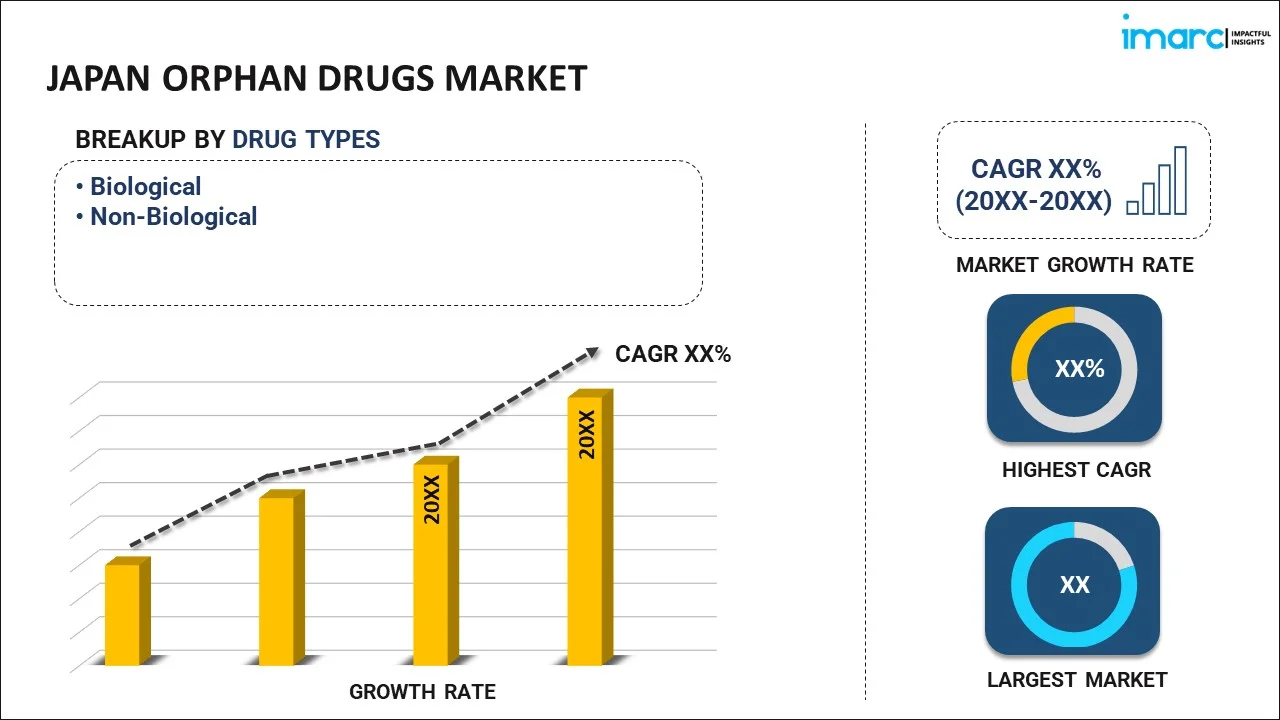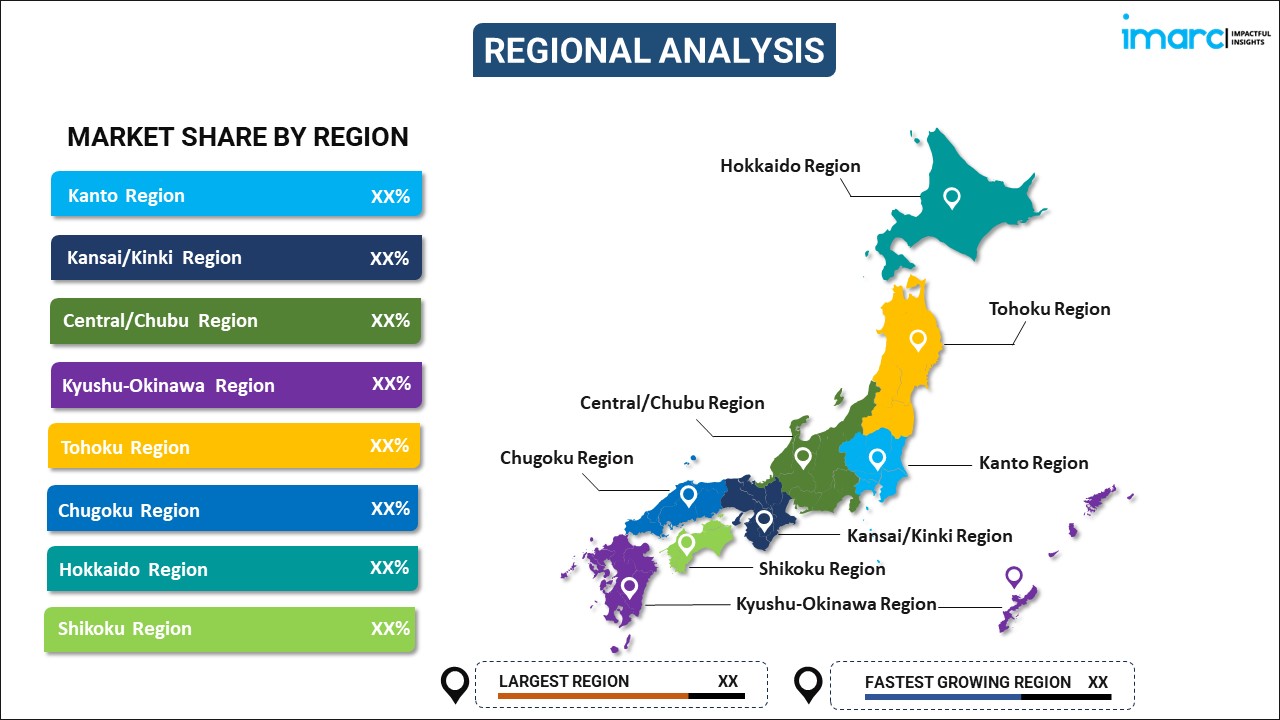
Japan Orphan Drugs Market Report by Drug Type (Biological, Non-Biological), Disease Type (Oncology, Hematology, Neurology, Cardiovascular, and Others), Phase (Phase I, Phase II, Phase III, Phase IV), Top Selling Drug (Revlimid, Rituxan, Copaxone, Opdivo, Keytruda, Imbruvica, Avonex, Sensipar, Soliris, and Others), Distribution Channel (Hospital Pharmacies, Retail Pharmacies, Online Stores, and Others), and Region 2025-2033
Market Overview:
Japan orphan drugs market size reached USD 1,4034 Million in 2024. Looking forward, IMARC Group expects the market to reach USD 32,687 Million by 2033, exhibiting a growth rate (CAGR) of 9.8% during 2025-2033. The rising number of rare diseases lacking treatment, along with improving access to healthcare, represent some of the key factors driving the market.
|
Report Attribute
|
Key Statistics
|
|---|---|
|
Base Year
|
2024 |
|
Forecast Years
|
2025-2033
|
|
Historical Years
|
2019-2024
|
| Market Size in 2024 | USD 1,4034 Million |
| Market Forecast in 2033 | USD 32,687 Million |
| Market Growth Rate (2025-2033) | 9.8% |
Orphan drugs are pharmaceutical products designed for the diagnosis, prevention, and treatment of rare medical conditions. These medications are developed to address specific healthcare needs and typically have a limited market because they are intended for a small number of patients. They prove effective against a wide range of medical conditions, including but not limited to oncological, metabolic, hematologic, immunologic, infectious, and neurological diseases. In addition to this, many of these conditions, such as lymphoma, leukemia, cystic fibrosis, glioma, pancreatic cancer, ovarian cancer, multiple myeloma, and renal cell carcinoma, are often life-threatening, chronic, progressive, degenerative, and disabling. They necessitate specialized treatment options that are tailored to address their unique symptoms. Consequently, orphan drugs are widely utilized in hospitals across Japan.
Japan Orphan Drugs Market Trends:
In the context of the Japan market, several factors are fueling market growth. One significant driver is the increasing prevalence of cancer and rare genetic disorders. Pharmaceutical manufacturers are actively developing innovative orphan drugs to offer personalized therapy options to patients in response to this growing demand, thereby positively influencing the regional market. Furthermore, the market is benefiting from heightened public awareness of the advantages of orphan drugs. Besides this, the emergence of new pharmaceutical companies in the market and the implementation of favorable government policies aimed at curbing the spread of contagious diseases are also contributing to this positive growth trajectory. In addition to these factors, various product innovations, such as the creation of biological orphan drugs, are serving as additional growth catalysts. These drugs have the capacity to treat diseases like cancer and reverse the damage inflicted on stem cells, significantly boosting their demand, which is acting as another significant growth-inducing factor. Moreover, improvements in healthcare infrastructure and a substantial focus on research and development (R&D) activities are expected to further propel the market's expansion.
Japan Orphan Drugs Market Segmentation:
IMARC Group provides an analysis of the key trends in each segment of the market, along with forecasts at the country level for 2025-2033. Our report has categorized the market based on drug type, disease type, phase, top selling drugs, and distribution channel.
Drug Type Insights:

- Biological
- Non-Biological
The report has provided a detailed breakup and analysis of the market based on the drug type. This includes biological and non-biological.
Disease Type Insights:
- Oncology
- Hematology
- Neurology
- Cardiovascular
- Others
A detailed breakup and analysis of the market based on the disease type have also been provided in the report. This includes oncology, hematology, neurology, cardiovascular, and others.
Phase Insights:
- Phase I
- Phase II
- Phase III
- Phase IV
The report has provided a detailed breakup and analysis of the market based on the phase. This includes phase I, phase II, phase III, and phase IV.
Top Selling Drugs Insights:
- Revlimid
- Rituxan
- Copaxone
- Opdivo
- Keytruda
- Imbruvica
- Avonex
- Sensipar
- Soliris
- Others
A detailed breakup and analysis of the market based on the top selling drugs have also been provided in the report. This includes revlimid, rituxan, copaxone, opdivo, keytruda, imbruvica, avonex, sensipar, soliris, and others.
Distribution Channel Insights:
- Hospital Pharmacies
- Retail Pharmacies
- Online Stores
- Others
The report has provided a detailed breakup and analysis of the market based on the distribution channel. This includes hospital pharmacies, retail pharmacies, online stores, and others.
Regional Insights:

- Kanto Region
- Kansai/Kinki Region
- Central/ Chubu Region
- Kyushu-Okinawa Region
- Tohoku Region
- Chugoku Region
- Hokkaido Region
- Shikoku Region
The report has also provided a comprehensive analysis of all the major regional markets, which include Kanto Region, Kansai/Kinki Region, Central/ Chubu Region, Kyushu-Okinawa Region, Tohoku Region, Chugoku Region, Hokkaido Region, and Shikoku Region.
Competitive Landscape:
The market research report has also provided a comprehensive analysis of the competitive landscape in the market. Competitive analysis such as market structure, key player positioning, top winning strategies, competitive dashboard, and company evaluation quadrant has been covered in the report. Also, detailed profiles of all major companies have been provided.
Japan Orphan Drugs Market Report Coverage:
| Report Features | Details |
|---|---|
| Base Year of the Analysis | 2024 |
| Historical Period | 2019-2024 |
| Forecast Period | 2025-2033 |
| Units | Million USD |
| Scope of the Report | Exploration of Historical Trends and Market Outlook, Industry Catalysts and Challenges, Segment-Wise Historical and Future Market Assessment:
|
| Drug Types Covered | Biological, Non-Biological |
| Disease Types Covered | Oncology, Hematology, Neurology, Cardiovascular, Others |
| Phases Covered | Phase I, Phase II, Phase III, Phase IV |
| Top Selling Drugs Covered | Revlimid, Rituxan, Copaxone, Opdivo, Keytruda, Imbruvica, Avonex, Sensipar, Soliris, Others |
| Distribution Channels Covered | Hospital Pharmacies, Retail Pharmacies, Online Stores, Others |
| Regions Covered | Kanto Region, Kansai/Kinki Region, Central/ Chubu Region, Kyushu-Okinawa Region, Tohoku Region, Chugoku Region, Hokkaido Region, Shikoku Region |
| Customization Scope | 10% Free Customization |
| Post-Sale Analyst Support | 10-12 Weeks |
| Delivery Format | PDF and Excel through Email (We can also provide the editable version of the report in PPT/Word format on special request) |
Key Questions Answered in This Report:
- How has the Japan orphan drugs market performed so far and how will it perform in the coming years?
- What has been the impact of COVID-19 on the Japan orphan drugs market?
- What is the breakup of the Japan orphan drugs market on the basis of drug type?
- What is the breakup of the Japan orphan drugs market on the basis of disease type?
- What is the breakup of the Japan orphan drugs market on the basis of phase?
- What is the breakup of the Japan orphan drugs market on the basis of top selling drugs?
- What is the breakup of the Japan orphan drugs market on the basis of distribution channel?
- What are the various stages in the value chain of the Japan orphan drugs market?
- What are the key driving factors and challenges in the Japan orphan drugs?
- What is the structure of the Japan orphan drugs market and who are the key players?
- What is the degree of competition in the Japan orphan drugs market?
Key Benefits for Stakeholders:
- IMARC’s industry report offers a comprehensive quantitative analysis of various market segments, historical and current market trends, market forecasts, and dynamics of the Japan orphan drugs market from 2019-2033.
- The research report provides the latest information on the market drivers, challenges, and opportunities in the Japan orphan drugs market.
- Porter's five forces analysis assist stakeholders in assessing the impact of new entrants, competitive rivalry, supplier power, buyer power, and the threat of substitution. It helps stakeholders to analyze the level of competition within the Japan orphan drugs industry and its attractiveness.
- Competitive landscape allows stakeholders to understand their competitive environment and provides an insight into the current positions of key players in the market.
Need more help?
- Speak to our experienced analysts for insights on the current market scenarios.
- Include additional segments and countries to customize the report as per your requirement.
- Gain an unparalleled competitive advantage in your domain by understanding how to utilize the report and positively impacting your operations and revenue.
- For further assistance, please connect with our analysts.
 Inquire Before Buying
Inquire Before Buying
 Speak to an Analyst
Speak to an Analyst
 Request Brochure
Request Brochure
 Request Customization
Request Customization




.webp)




.webp)












